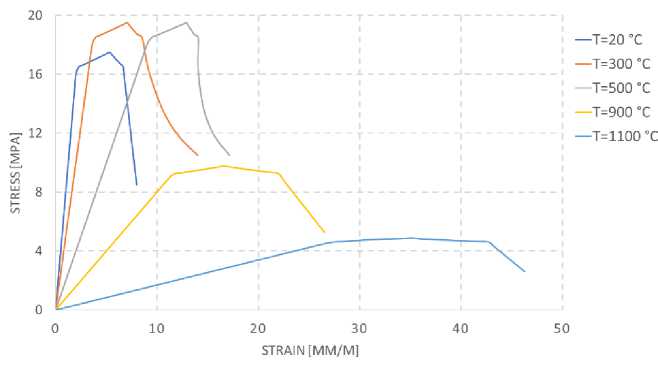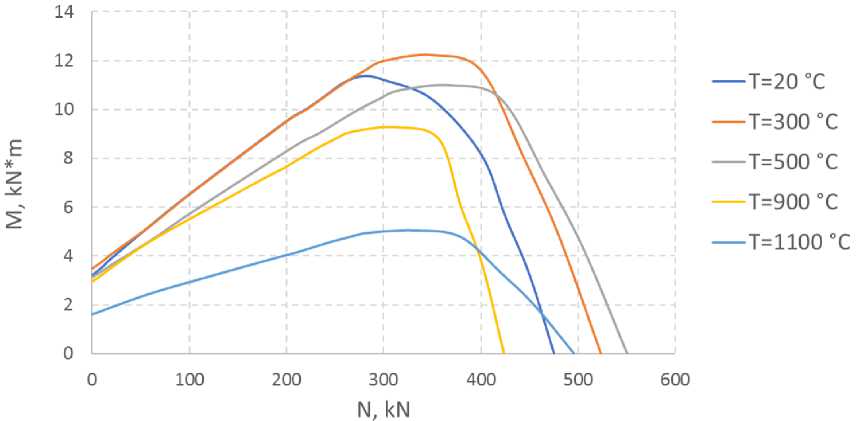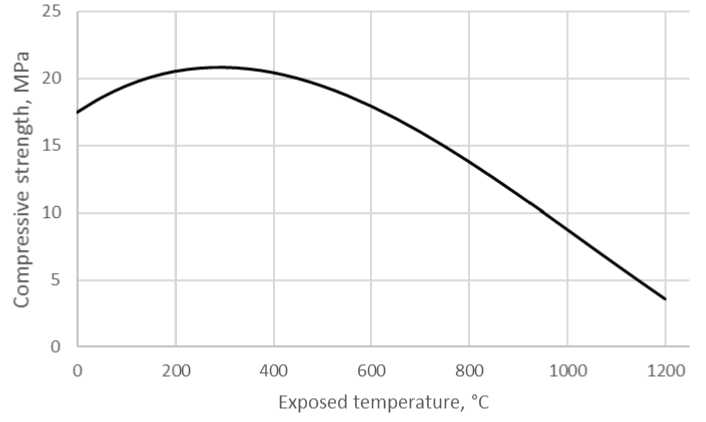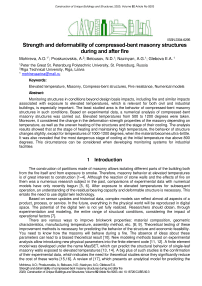Strength and deformability of compressed-bent masonry structures during and after fire
Автор: Mohireva Arina Olegovna, Proskurovskis Arturs, Glebova Ekaterina Alekseevna, Nazinyan Levon Gaikovic, Belousov Nikita Dmitrievich
Журнал: Строительство уникальных зданий и сооружений @unistroy
Статья в выпуске: 7 (92), 2020 года.
Бесплатный доступ
Monitoring of structures in conditions of beyond design basis impacts, including fire and similar impacts associated with exposure to elevated temperatures, which is relevant for both civil and industrial buildings, is especially important. The least studied area is the behavior of compressed-bent masonry structures in such conditions. Based on experimental data, a numerical analysis of compressed-bent masonry structures was carried out. Elevated temperatures from 500 to 1200 degrees were taken. Moreover, we took into account the change in the deformation-strength properties of the masonry depending on temperature, as well as the uneven heating of the structures and the stage of their cooling. The analysis results showed that at the stage of heating and maintaining a high temperature, the behavior of structure changes slightly, with the exception of temperatures of 1000-1200 degrees, when the material becomes ultra-brittle. It was also revealed that the most dangerous stage of cooling at the initial temperature rise above 800 degrees. This circumstance can be taken into account when developing monitoring systems for industrial facilities.
Elevated temperature, masonry, compress-bent structures, fire resistance, numerical models
Короткий адрес: https://sciup.org/143172533
IDR: 143172533 | УДК: 69 | DOI: 10.18720/CUBS.92.3
Текст научной статьи Strength and deformability of compressed-bent masonry structures during and after fire
The construction of partitions made of masonry allows isolating different parts of the building both from the fire itself and from exposure to smoke. Therefore, masonry behavior at elevated temperatures is of great interest to construction [1–4]. Although the reaction of stone walls and the effects of fire on them was a numerous research subject in the past, comparisons of experimental data with numerical models have only recently begun [5, 6]. After exposure to elevated temperatures for subsequent operation, an understanding of the residual bearing capacity and deformable structure is necessary. This entails the need to use digital twin technology.
Based on sensor updates and historical data, complex models can reflect almost all aspects of a product, process, or service. In the future, everything in the physical world will be reproduced in digital space. The potential of the digital twin is not yet fully realized. Researchers should obtain, through experimentation and modeling, the entire range of structural conditions, considering the impact of operational factors [7].
There are various ways to improve brickwork properties: material composition, geometric characteristics, manufacturing temperature, assembly method, etc. [8; 9]. Theoretical testing of these improvement methods is necessary for predicting the behavior of the structure and economic feasibility. You need to know how the masonry will behave during a fire. The absence of ideas about these parameters can lead to a biased theoretical result [10]. New modeling methods based on experimental analysis allow introducing new physical parameters into the finite element code [11, 12]. A finite element model was developed under the name MasSET, which can predict the structural behavior of single-leaf masonry walls exposed to elevated temperatures [13, 14]. A big plus of such studies is the confirmation of their experimental data, which indicates the need for theoretical studies since they significantly reduce the cost of these works [15,16]. A review of [17], which presents an analytical model for predicting the mechanical resistance of solid blocks of masonry panels taking into account European standards EN 1996-1-2, confirms the idea of the relevance of this study. It is necessary to study various parameters and methods of masonry behavior indicated in [18, 19], where the crushing moment crushing domains were determined with axial force to increase the exposure time to the rated fire, taking into account different types of stress-strain-temperature constitutive relations. The fire resistance of stone walls made of hollow burnt clay bricks was experimentally studied in [20, 21], while in the bearing walls, local spallation of bricks is considered as an important factor regulating the fire resistance of masonry walls. The burnt-clay masonry is also investigated by simulating the finite element method. The emphasis was on the risk of spalling. The modeling performed in this article also showed results that coincide with the experimental ones [22].
Based on the foregoing, the study aims to obtain the characteristics of the stress-strain state of compressed-bent elements of stone structures under conditions of acquired inhomogeneity in deformations and strength from temperature effects in the range from central compression to pure bending.
2 Materials and Methods
The masonry deformation curves were taken as initial data under conditions of preliminary heating to a temperature of 600 K, 800 K, 1200 K, and 1400 K (Fig 1.). The change in compressive and tensile strength was considered, and the change in the initial elastic modulus after exposure to elevated temperatures.
The calculation was performed by the finite element method in the program “ABAQUS”

Fig 1. Masonry deformation curves for the considered temperature effects
The calculations were carried out using the ABAQUS software in a non-linear setting. An iterative procedure was used, according to which the values of the modulus of elasticity of the material of the cellular concrete blocks were refined for each loading level. The masonry's plastic behavior was also taken into account, which was specified for cases of exceeding the modulus of elasticity limit. The compress-bent element's Structural scheme is presented in Figure 2, in a plane stress condition using rectangular finite elements. For calculation, an appropriate limiting moment was selected by iteration with an increment of 0.05а for each compressive force level, with a step of 10–20 kN.

Fig 2. Structural scheme of compress-bent element
For the formula's analytical derivation, an approximation of the ultimate strength values obtained from the experimental data was used. In this case, the least-squares method using cubic regression was used [23].
3 Results and Discussion
A graph was constructed of combinations of ultimate bending moments and compressive forces for the temperatures in question (Fig 3). It follows that with compressive forces of up to 300 kN, the limiting state occurs in the stretched zone from the bending moment. After 400 kN, the limiting state first occurs in the compressed zone due to the transverse force's eccentricity. In this case, an increase in temperature to 300 ° C increases the strength, which can be explained by the removal of the natural moisture of the masonry.

Fig 3. Interaction curves “M-N” for the considered temperatures
An example of a specimen's stress-strain state that corresponds to the forces N = 220 kN and M = 2.51 kN∙m is shown in Figure 4. In this case, see a nonuniform distribution of stresses caused by the appearance of plastic deformations in the compressed zone, corresponding to the local crushing of the masonry area and the subsequent occurrence of dangerous tensile stresses on the lower surface of the specimen.
S, Max. In-Plane Principal (Abs) (Avg: 75%) i+l,812e+06 -2.349e+05 -2.282e+06 -4.329e+06 -6.376e+06 -8.422e+06 -1.047e+07 -l,252e+07 ■1.456e+07 -1.661e+07 -1.866e+07 •2.070e+07 -2.275e+07

Fig 4. Stress-strain state of a specimen under action N=220 kN и M=2.51 kN∙m, T=300 °C
In addition to finite element modeling, dependence (1) was derived, which reflects the approximation of experimental data for compressive strength.
R = R0(9 * 10-10T3 - 2.8 * 10-6 *T2 + 1.4 * 10-3 * T + 1)
Where:
R - actual compressive strength
R 0 - initial compressive strength
Т - exposed temperature
The coefficients used are derived from the approximation regression and require theoretical justification
Based on this formula, a graph was constructed (Fig 5.)

Fig 5. Analytical dependence of masonry strength on exposed temperature
The graph shows the dependence of compressive strength on the temperature of the transferred impact. This function will be executed up to 1200 ° C. There is currently no enough experimental data for high temperatures; however, assume that further with increasing temperature, the strength will not change significantly until the fire resistance and destruction limit are reached.
4 Conclusions
The finite element analysis of a compressed-flexible structure showed that the behavior of the material during fracture in the compressed zone changes the most, while the tensile strength changes insignificantly. The homogenized model values require additional refinement and can be further refined using detailed modeling of the masonry element as a combination of "brick plus mortar".
From the experimental data of the curves of masonry deformation under conditions of preheating, an analytical expression of the residual malleability of the masonry element was obtained. The obtained dependence can be used in digital doubles of stone structures. However, it is applicable only for elements compressed centrally or with slight eccentricities. The obtained coefficients are derived analytically and require theoretical justification, which may be the subject of further research.
The use of these calculations in the Digital Double technology can substantially reduce the cost of designing, erecting, and operating structures by accurately assessing the cost of each stage of the structure's life cycle with minimal and sufficient reserves.
DOI:10.4028/
Список литературы Strength and deformability of compressed-bent masonry structures during and after fire
- Th.-D. Nguyen, F. Meftah. Behavior of clay hollow-brick masonry wall sduring fire. Part1: experimental analysis. FireSaf. 2012. 52 Pp. 55-64. DOI: 10.1016/j.firesaf.2012.06.001
- T. Saknite, D. Serdjuks, V. Goremikins, L. Pakrastins, N.I. Vatin. Fire design of arch-type timber roof. Magazine of Civil Engineering. 2016. 64(4). Pp. 26-39. DOI: 10.5862/MCE.64.3
- M.V. Gravit, O.V. Nedryshkin, O.T. Ogidan. Transformable fire barriers in buildings and structures. Magazine of Civil Engineering. 2018. 77(1). Pp. 38-46. DOI: 10.18720/MCE.77.410.18720/MCE.77.4
- M. Gravit, I. Dmitriev, A. Ishkov. Quality control of fireproof coatings for rein-forced concrete structures. IOP Conference Series: Earth and Environmental Science. 2017. 90(1). DOI: 10.1088/1755-1315/90/1/012226
- D. Nguyen, A. Mebarki. The behaviour of masonry walls subjected to fire: Modelling and parametrical studies in the case of hollow burnt-clay bricks. Fire Safety Journal. 2009. 44(4). Pp. 629-64. DOI: 10.1016/j.firesaf.2008.12.006
- A. Krivtcov, M. Gravit, S. Zimin, O. Nedryshkin, V. Pershakov. Calculation of Limits of Fire Resistance for Structures with Fire Retardant Coating. MATEC Web of Conferences. 2016. 53.
- DOI: 10.1051/matecconf/20165301032
- Q. Qi, Fei Tao, T.Hu, N. Anwer, A. Liu, Y. Wei, L. Wang, A.Y.C. Nee. Enabling technologies and tools for digital twin. Journal of Manufacturing Systems. 2019. 29.
- DOI: 10.1016/j.jmsy.2019.10.001
- M. Kornmann. Clay Bricks and Rooftiles. Manufacturing and Properties, Société de l'industrie Minérale. 2007.
- O. Nedryshkin, M. Gravit, K. Grabovyy. Modeling fires in structures with an atrium in the FDS field model. MATEC Web of Conferences. 2018. 193.
- DOI: 10.1051/matecconf/201819303023
- K.R. Kodur, M. Garlock, N. Iwankiw, Structures in fire: state-of-the-art, research and training needs. Fire Technol. 2012. 48. Pp. 825-839.
- DOI: 10.1007/S10694-011-0247-4
- S. Russo, F. Sciarretta, Masonry exposed to high temperatures: mechanical behavior and properties- an overview. Fire Safety Journal. 2013. 55. Pp. 69-86.
- DOI: 10.4028/www.scientific.net/AMR.875-877.1544
- M. Gravit, V. Lyulikov, A. Fatkullina. Possibilities of modern software complexes in simulation fire protection of constructions structures with Sofistik. MATEC Web of Conferences. 2018.
- DOI: 10.1051/matecconf/201819303026
- A. Nadjai, M. O'Garra, F. Ali. Finite element modelling of compartment masonry walls in fire. School of the Built Environment, University of Ulster, Newtownabbey, UK Received. 2003.
- DOI: 10.1016/S0045-7949(03)00212-8
- M.V. Gravit, M.D. Terekh, V.A. Lyulikov, S.A. Svintsov. Software packages for calculation of fire resistance of building construction, including fire protection. IOP Conference Series: Materials Science and Engineering. 2018. 456(1).
- DOI: 10.1088/1757-899X/456/1/012016
- DJ. O'Connor, A. Nadjai, ME. O'Gara. A numerical model for the behaviour of masonry under elevated temperatures. In: Proc. Fourth Int. Conf. Comp. Struct, Edinburgh, Civil- Comp Press, Edinburgh. 2003.
- DOI: 10.1002/FAM.824
- D. Nguyen, Meftah F. Behavior of hollow clay brick masonry walls during fire. Part 2: 3D finite element modeling and spalling assessment. Fire Safety Journal. 2014. 66 Pp.35-45
- DOI: 10.1016/J.FIRESAF.2013.08.017
- M. Andreini, M. Sassu. Mechanical behaviour of full unit masonry panels under fire action. Department of Civil Engineering - Structural Division, University of Pi-sa Largo Lucio Lazzarino. 2011.
- DOI: 10.1016/J.FIRESAF.2011.07.004
- F. Sciarretta. Modeling of mechanical damage in traditional brickwork walls after fire exposure, Adv. Mater. Res. 2014. 919 Pp. 495-499.
- DOI: 10.4028/www.scientific.net/AMR.919-921.495
- E. Nedviga, N. Beresneva, M. Gravit, A. Blagodatskaya. Fire Resistance of Pre-fabricated Monolithic Reinforced Concrete Slabs of "Marko" Technology. Advances in Intelligent Systems and Computing. 2018. 692. Pp. 739-749.
- DOI: 10.1007/978-3-319-70987-1_78
- V.A. Rybakov, I.A. Ananeva, A.O. Rodicheva, O.T Ogidan. Stress-strain state of composite reinforced concrete slab elements under fire activity. Magazine of Civ-il Engineering. 2017. 74(6). Pp. 161-174.
- DOI: 10.18720/MCE.74.13
- V. Pershakov, A. Bieliatynskyi, I. Popovych, K. Lysnytska, V. Krasheninnikov. Progressive Collapse of High-Rise Buildings from Fire. MATEC Web of Conferences. 2016.
- DOI: 10.18720/MCE.74.13
- M. Andreini, A. Falco, M. Sassu. Stress-strain curves for masonry materials ex-posed to fire action, Fire Safety Journal. 2014. 69. Pp. 43-56.
- DOI: 10.1016/J.FIRESAF.2011.07.004
- J. Bošnjak, S. Gambarelli, A. Sharma, A. Meškovic. Experimental and numerical studies on masonry after exposure to elevated temperatures. Construction and Building Materials. 2020. 230.
- DOI: 10.1016/j.conbuildmat.2019.116926


